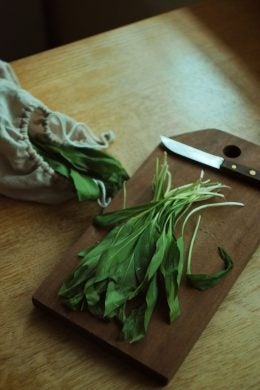The Nose Knows! A Guide to Harvesting/Identifying Wild Onion & Garlic
Megan Plete Postol 05.24.21

Wild onion (Allium Canadense) and wild garlic (Allium Vineale) are commonly confused. While both are aromatic and delicious, they are indeed two separate delicacies. They are both related to asparagus, chives, and shallots. All are edible. The confusion between wild onion and wild garlic roots from both references and appearances. They are often referred to interchangeably by the names leeks, wood leeks, ramps, field onion, etc. Aesthetically they are often confused for one another because they look very similar. Both are perennials, meaning they grow year after year, and both grow from bulbs.

Where to Find Wild Onion, Wild Garlic, and What They Look Like
The time to find these wild edibles is Spring, after the snow has passed and the weather has turned warmer. Both grow well in damp, marshy, wooded areas. They can also grow along rocky river edges. Like most plants they thrive in rich soil and partial sun, but can grow in poor soil as long as there is adequate water. Both wild onions and wild garlic have thin, glossy, waxy green leaves. While wild onion leaves are flat and solid, wild garlic leaves are round and hollow. Wild onion leaves emerge from the base while wild garlic leaves branch off the main stem. The flowers of the wild onion are generally white or pink.
The flowers of the wild garlic are typically green or purple. Aside from appearances, both wild onion and wild garlic have a signature fragrance that will linger in the air when they have been disturbed. When harvesting wild onion and wild garlic, pull from the bottom to ensure you get the whole stalk; both the green leaves and white lower stalk are edible. It can be helpful to bring a small trowel out with you to use to loosen the soil around the leeks. Once pulled, shake the dirt off and rinse before consuming.
Dangerous Dopplegangers
When identifying wild onions and/or wild garlic, the aroma is important. There are other similar-looking plants that are toxic. The lookalikes do not have the signature scent of onion and/or garlic that will be a signal that you have found the correct plants. Being absolutely sure on visual identification is also important, though. Other plants, such as lily-of-the-valley have similar looking leaves to wild onion, but lily-of-the-valley is poisonous. Skunk cabbage also has leaves that look similar, but are more veined than onion family leaves; and instead of a bulb, the skunk cabbage has a fibrous root. Skunk cabbage is not a deadly plant, but it can make you sick. Death camas (Zigadenus Venenosus) is a toxic plant that has a similar shape and flowers as wild garlic, and should be considered dangerous.
When in doubt, consult a guidebook. A few good ones to check out are:
- “The Forager’s Harvest: A Guide to Identifying, Harvesting, and Preparing Edible Wild Plants,” by Samuel Thayer
- “Edible Wild Plants: A North American Field Guide to Over 200 Natural Foods,” by Thomas Elias and Peter Dykeman
- “Adventures in Edible Plant Foraging: Finding, Identifying, Harvesting, and Preparing Native and Invasive Wild Plants,” by Karen Monger
Although harvesting wild onions and garlic has grown in popularity over the past few years, this is not a new trend. Native Americans have foraged them for centuries. The name of the city Chicago even comes from the indigenous word “shikaakwa” which translated to “smelly onion,” referencing the abundance of wild onions that grew in that area.

Preparation & Storage
To prepare wild onions and wild garlic, rinse them to remove any debris. The entire plant is edible – raw or cooked – and can be enjoyed in a variety of ways. They can be tossed in salads, soups or other dishes. They can be pickled, grilled, or fried. Cook them in butter or bacon fat on the stovetop until soft. Below is just one suggested recipe, but these seasonal wonders can be utilized in many different recipes. More recipes can be found here.
Pickled Wild Onions – Ingredients
- 1/2 pound cleaned wild onions
- 1 tsp black mustard seed
- 3 tsp fennel seed
- 4 tsp coriander seed
- 2/3 cup raw honey
- 4 cups apple cider vinegar
- 2 1/3 cup of filtered water
Directions: In a medium saucepan, roast the spices on medium heat until fragrant, and add water and apple cider vinegar and bring to a boil. Put the wild onions into a clean glass Mason jar or container, and pour pickling liquid over them. Cover with a lid, and allow it to cool at room temperature. Refrigerate for a week, and use it with just about everything, including salads, or as a side.
To keep your harvest fresh, roll onions and garlic (separately) in a damp paper towel, place in an unsealed bag, and keep them in the fridge. They will stay fresh stored this way for up to two weeks. Another option for short-term storage is to place the whole plant (stalk and leaf) in a glass jar filled with water. For longer term storage, they can be frozen or dehydrated.
